Inevitably when you use music and audio equipment, you’re going to get some wear and grime build-up – and potentially expose yourself to unwanted germs. We use these tools with our hands and mouths and often leave them exposed to environmental elements. We want to highlight a few simple and inexpensive ways you can disinfect your gear and help maintain top performance and cleanliness.
How to Clean a Guitar
Guitars go through a lot. Not only are they used at home, but they are tools used to perform in front of hundreds or thousands of people at a time. Finger smudges, dirt, sweat, beer, germs, and sufficient DNA to clone someone are usually collected on any given guitar.
How Do You Keep Your Guitar Clean?
Keeping your guitars clean isn’t exclusively to do with chemical cleaners. How you treat and store your instrument goes a long way into keeping it clean and sanitized. Examples include washing your hands before and after playing your guitar, wiping your strings down after use, storing in a case when not being used, and not sharing your guitar with a different set of hands. Of course there’s no way to 100% guarantee your instrument doesn’t pick up unwanted germs and dirt, especially when being exposed to different environments, but simple steps can go a long way in keeping major maintenance and cleanings to a minimum.
Preparing Your Guitar for Cleaning
It’s always good to use a dry rag or towel on your guitar to get rid of any dust or dirt that might be lingering on the surface. You also want to check for sensitive areas and where to avoid the electronics.
How to Clean Electric Guitars
When using any cleaner, always apply a light amount to a cloth, preferably a microfiber cloth to not scratch the finish of your guitar. This will also give you much better control over where any cleaner or polishing solution is used and keep it away from your electronics. Applying directly to the guitar could also mean water droplets dry and oxidize the strings or other metal surfaces if they’re not wiped down properly. Wipe in a circular motion and give special attention to areas that might have more buildup or splotches. Be sure to dry the guitar with another microfiber cloth after applying.
How to Clean Acoustic Guitars
Acoustic guitars can be a little easier than electrics since many don’t have electronics, or those that do have them in a much smaller area. The woods on an acoustic guitar are more exposed, so be extra careful to only lightly saturate your microfiber cloth so the wood doesn’t absorb any moisture which could cause stains in the finish. Same general rules apply for wiping in a circular motion and being mindful of the electronics when present.
Best Guitar Cleaners To Use
There are plenty of guitar cleaners on the market, and even some traditional cleaners that work well, but you want to find something water-based like our Goby Labs Guitar Polish to help protect your guitar’s finish. Delicate finishes will damage with the caustic chemicals found in some alcohol-based cleaners, but water-based solutions are safe to use. Just be sure not to use too much on any open-grain guitar, which will absorb moisture. Make sure to always apply cleaner and polish with a microfiber cloth so that you don’t scratch the surface in the process.
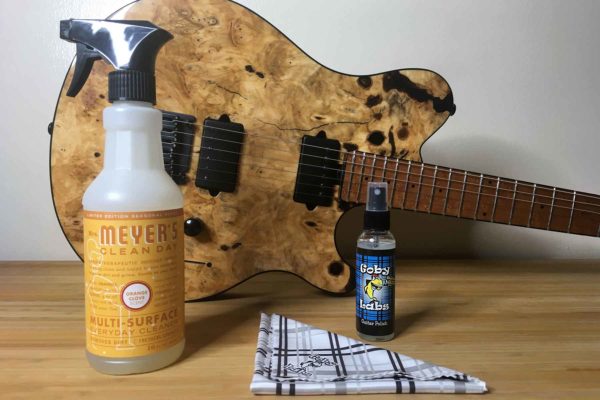
How to Clean and Sanitize Guitar Fretboards
Your fretboard, or fingerboard, is the area that will require the most attention since it’s where your hands are always making contact, building up dirt, grime, grease, sweat, and anything lingering on your fingers. In order to make sure you fully clean your fretboard, it’s best to remove your strings, or loosen them to clear the fretboard entirely. Use a lightly saturated microfiber cloth to wipe down between each fret in a parallel motion to the fret itself. Make sure to give special attention to the area right around the fret itself since that tends to collect the most dirt and grime.
Speaking of caustic chemicals, some solutions can dry out unfinished fretboards if used improperly. Rubbing alcohol is fine to use for disinfecting unfinished woods like rosewood, ebony, and maple. If you have a lacquered board, a cloth very lightly dampened with soap and water will do the trick. After disinfecting porous woods, like rosewood, apply our oil-based Goby Labs Fingerboard Conditioner to cut through grime without damaging the wood. Just make sure to apply it with a microfiber cloth and remove any excess oil after applying.
Goby Labs Guitar Polish and Fretboard Conditioner come conveniently together with a microfiber cloth in the Goby Labs Guitar Care Kit to ensure you have everything you need to care for your axe.
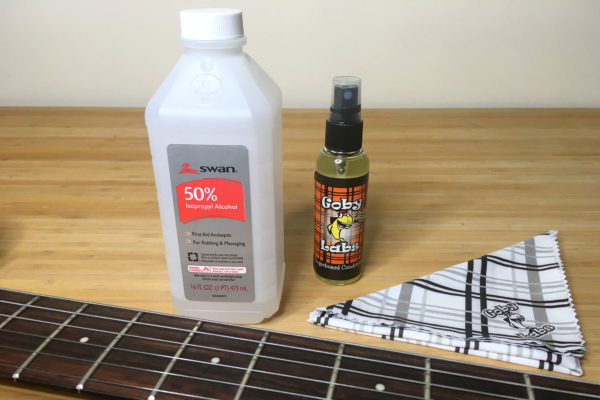
How to Sanitize Microphones
Microphones are probably the most challenging piece of gear to clean and sanitize given how frequently they come in contact with our mouths. Most cleaning solutions require pre-saturated wipes or a cloth partially saturated in an alcohol-based solution. However, there are some more convenient options.
The solution we most recommend is our Goby Labs Microphone Sanitizer. This sanitizer has the added convenience of simply being sprayed directly onto the microphone grill. It soon evaporates, without damaging the inner electronics. It’s the easiest way to sanitize quickly for venues and karaoke clubs where a single microphone is used by many people on the same night.
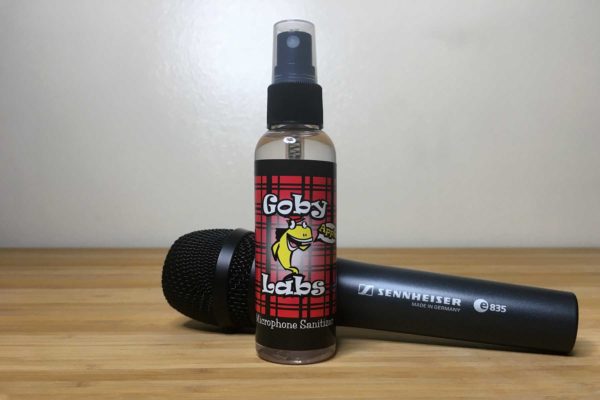
How to Sanitize Audio Hardware
Surfaces on hardware usually only need a towel or rag lightly dampened with water or surface cleaner to wipe them down. You want to protect the electronics inside, so it’s never a good idea to spray anything directly on the surface, and always remember to power down any electronic device before cleaning and sanitizing to avoid shorting out the equipment.
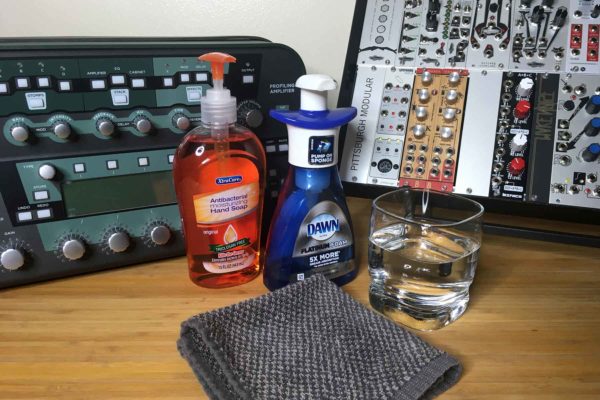
For home studio applications, our Goby Labs Equipment Care Kit includes Headphone Cleaner to remove the dirt and grime build-up without damaging delicate electronics, Screen Cleaner that’s safe for use on LCD screens, Microphone Sanitizer, and a microfiber cloth.
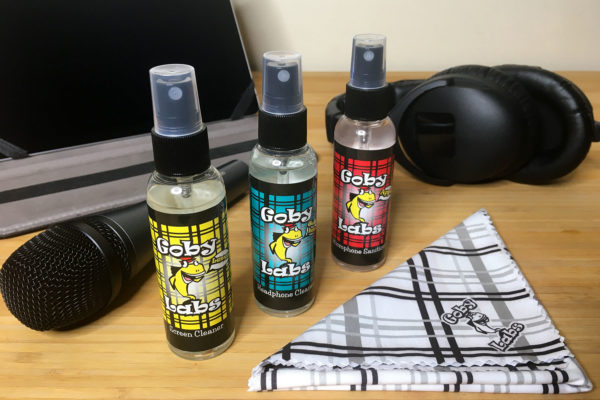
How to Clean Audio Cables
It’s usually a good idea to keep water away from cables so you don’t promote oxidation and corrosion, but after they’ve seen a few gigs and have been stepped on a few hundred times, we get it. A lightly dampened cloth with soap and water is sufficient to run along the length of the cord and housing of a connector, just don’t pull too hard to avoid severing the solder or creating a short in the cable.
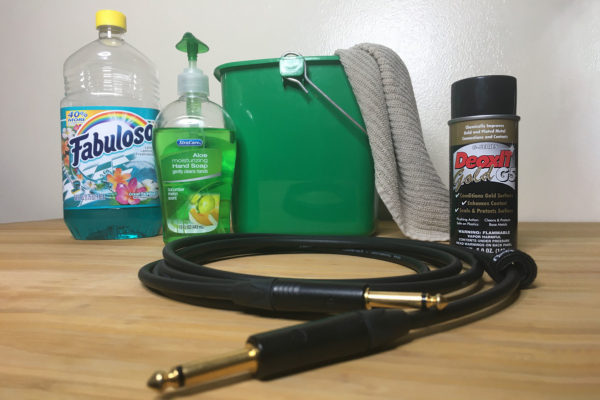
Maintaining Your Connectors
If you wish to clean the contact points of your cables, it’s best to use an electric contact cleaner like CAIG Laboratories’ DeoxIT Gold, a less concentrated maintenance cleaner that leaves behind an added layer of protection.
How to Keep Your Hands Clean
At this point, you probably don’t need us to preach the efficacy of hand sanitizers, but it’s worth noting that Goby Labs also offers a 2oz spray bottle of FDA-approved hand sanitizer that fits conveniently next to our other cleaning solutions for gigging professionals on the go. Of course, good old-fashioned soap and water always works when available. Just make sure you wash your hands thoroughly for the recommended 15-30 seconds to ensure they are disinfected. A simple way to time yourself is singing “Happy Birthday” twice.
For those wearing gloves, we all know the sacrifice is your natural touch-sensitivity. This is why Hosa also offers HAND-E-GLOVE, a lotion that leaves a thin, invisible layer covering your hands. This allows for the best of both worlds with the protection of wearing a glove while preserving your natural sense of touch. We also offer HAND-E-SCRUB to clean and exfoliate your hands after use.
For more information on what solutions we offer to clean your musical instruments and audio gear, visit our Cleaners & Conditioners page.
- Hosa



